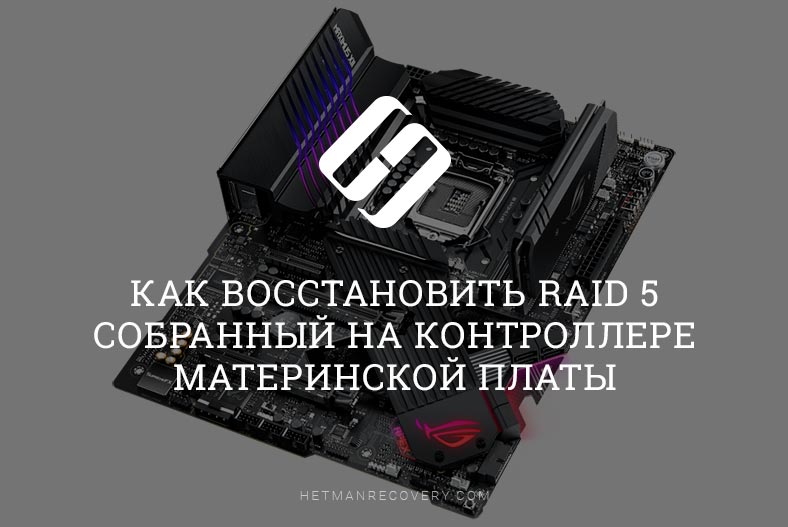
RAID technology allows several times to increase the speed of reading / writing data to a disk, and also provides a certain level of fault tolerance of drives. That is why this technology is widely used by all sorts of organizations, from small offices to huge corporations. Basically, extremely important data is stored on RAID to ensure safety. But at the same time, there is nothing eternal on Earth, and arrays are no exception. A variety of factors can affect the safety of data: OS failure, power outage, equipment failure, human error, etc.
The main question in this case is how to return it to work, or how to copy important files? What to do in such situations will be discussed in this article.
How to replace a failed disk
If one disk fails, the RAID status information will be displayed before the operating system boots, where you will see that it is damaged. In my case, this is the fifth type.

To replace a non-working drive with a new one, open the Intel Rapid Storage Technology menu. To do this, at boot, press the keyboard shortcut Ctrl + I.
Here you will see a list of all your media, by the serial number you can determine which of the disks is not working.

Shut down your computer and then unplug this drive. Then plug in a working media in its place, restart the PC. Open the Intel RST menu, then you will be prompted to fix the damaged array by adding a new disk for rebuild.

To select the desired media, select it, press Enter, and then the status will change to Rebuild. And at the bottom there is a message that “Volumes with the“ Rebuild ”status will be rebuilt in the operating system. Press 6 to exit, continue loading the operating system.

The wrong disks were accidentally excluded from the array. Reset Disk to Non-RAID
If you accidentally specified the wrong media for rebuild or excluded it from RAID, then after the OS boots the entire array will be damaged, and all stored data will be inaccessible. To retrieve data from a damaged array, use the Hetman RAID Recovery utility .
This software supports all types of RAID, and is capable of recovering information from non-working arrays or drives that it consisted of. It subtracts the parameters of the array and information about the motherboard on which it was built. Then it will rebuild the destroyed array and restore the information.
The program immediately determines the parameters of the array and automatically rebuilds it. Detailed information is displayed at the bottom of the utility window.

Before starting the recovery process, you must take care of the availability of a drive with sufficient volume for the information being recovered.
Right-click on the section icon and select "Quick Scan". When the scanning process is completed, it remains only to mark the necessary files or directories, click on "Restore". Then, we indicate the path to save the recovered files and confirm the operation. Upon completion, all files will be in the specified directory.

If a quick search does not show the results you want, then run the "Full Analysis". This process will take longer, but will allow you to find all the available information that has remained on the media, including deleted files.
What to do if the motherboard is out of order
Due to a hardware failure, or a direct breakdown of the motherboard, if you connect the drives to another PC, then you will not be able to do without third-party information recovery software. Because another controller on the motherboard will not be able to determine the parameters of the array. And the OS in disk management will offer to initialize or format them.

In no case should you do this, as it is guaranteed to delete all the remaining data on the media. The utility will automatically rebuild the RAID, allow you to scan disks and restore the necessary files.
Removal from the Intel Rapid Storage Technology menu. Delete Volume
Hetman RAID Recovery will recover your data even if you completely remove the RAID from the Intel RST menu.

In such a scenario, the program determined the type of the destroyed array and automatically assembled it. You just need to scan it and return the files you need.

If the program somehow failed to automatically assemble the destroyed array, you need to do it manually through the RAID constructor.
Specify the type Create manually and click "Next", here you need to specify all the parameters of the array.
Array type, block size, order, how many media it consisted of, select them from the list and indicate the correct order. The missing ones need to be filled with empty ones. After entering all the parameters, click "Add" and it will immediately appear in the disk manager. All that remains is to scan and restore the files you need.

The fifth RAID remains operational even after one drive breaks down, but if 2 disks stop working, it becomes completely inoperative and you will not be able to get the necessary files out of it. With the help of our program, you can recover information without two or more media, but some of the data will be damaged.
See the source for the full article with all additional video tutorials . And also visit our Youtube channel , more than 400 training videos are collected there.